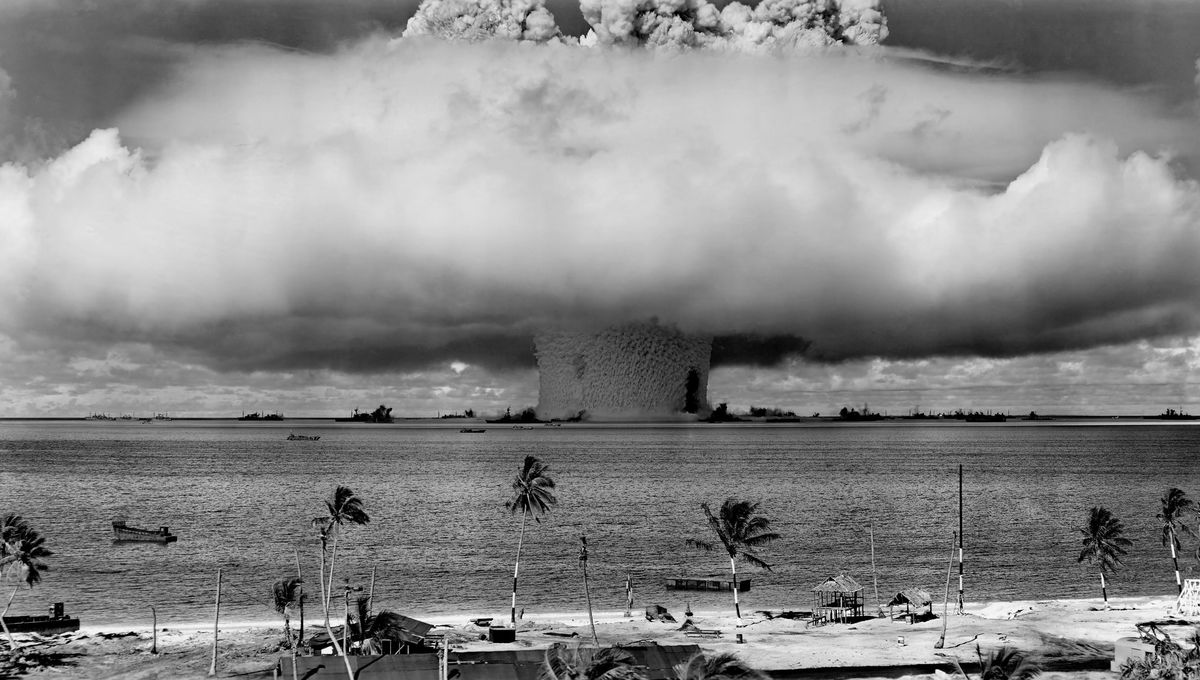
A new study into the legacy of the US nuclear weapons tests in the Marshall Islands has shown the impacts were significantly greater than has previously been acknowledged.
The research, which was commissioned by Greenpeace and conducted by the Institute for Energy and Environmental Research (IEER), found that all atolls in the Marshall Islands received radioactive fallout during the 67 tests the US conducted between 1946 and 1958, but only three received medical cancer screening. This was despite the islands being populated at the time.
The Marshall Islands are a chain of 29 coral atolls – ring shaped islands formed from coral reefs that encircle lagoons – located in the central Pacific Ocean, between Hawaii and the Philippines. The islands within these atolls have been occupied by humans for thousands of years – but the last century has been particularly turbulent for these communities.
In 1914, the Japanese captured the islands and built military bases there. During this time, the Japanese exercised a militarized regime that forcibly conscripted many locals into their labor force, especially during World War Two. Then, in February 1944, the US army defeated the Japanese on key atolls and effectively liberated them. However, the US recognized the value of these isolated islands for its nuclear weapons programs. Despite the islands having a population of 52,000 people, the US conducted dozens of tests, which spread nuclear fallout throughout the atolls.
The first tests were designed to investigate the impacts nuclear weapons had on naval warships. The tests started at Bikini Atoll in July 1946 and then moved onto thermonuclear weapons testing at Enewetak Atoll in 1951. These later tests were crucial in the eventual development of the first hydrogen bombs. In 1954, the US tested its largest nuclear explosion ever with Castle Bravo, which was 1,000 times stronger than the weapon that was dropped on the Japanese city of Hiroshima in August 1945.
In this latter test, which exceeded expectations, vast amounts of fallout made up of destroyed coral, water, and other irradiated materials, were transported in the air as snowflake-like ash. Traces of the fallout were distributed across the world, turning up in Japan, India, Australia, Europe, and the US. The public response to this disaster was massive, resulting in global condemnation of nuclear weapons testing.
According to the new IEER report, the capital of the Marshall Islands, Majuro, was officially considered a “very low exposure” atoll. However, radiation levels were tens of times higher than the background gamma radiation levels.
During the decade or so of testing, the Marshallese were unaware of the dangers they were exposed to. Since then, many Marshallese have experienced higher rates of cancer and birth defects, among other conditions. In 2004, the National Cancer Institute estimated the total cancer incidence of the Marshall Islands to be 500 excess cancers due to the nuclear tests, and that 87 percent of them would be located in the northern atolls – which experienced more fallout. The remaining cancers were estimated to have impacted the southern atolls. Then, in 2010, a US government-sponsored study adjusted this to 170 excess cancers.
However, there are many who believe these figures are too conservative and downplay the true extent of the damages – physical, psychological, and environmental – and risks imposed by the tests. Moreover, organizations like Greenpeace, as well as the Marshallese themselves, believe the deadly legacy of the nuclear exposure persists to this day.
“Among the many troubling aspects of the Marshall Islands’ nuclear legacy is that the United States had concluded, in 1948, after just three tests that the Marshall Islands was not ‘a suitable site for atomic experiments’ because it did not meet the required meteorological criteria. Yet testing went on,” Arjun Makhijani, report author and president of the IEER, explained in a statement.
IEER based its findings on a comprehensive assessment of official documents from the US government, military, and energy archives, as well as scientific analysis and medical sources from 1945 to the present.
The report and the IEER’s and Greenpeace’s ongoing work aims to raise greater awareness of the situation in the Marshall Islands, as well as to campaign for compensation from the US government.
“The tests on the Marshall Islands are exemplary of an inhumane, imperial policy that deliberately sacrificed human lives and ignored Pacific cultures. As a result of this nuclear legacy, the Marshallese have been robbed of their land, traditions, and culture, with the people of Bikini and Rongelap forever displaced,” Shiva Gounden, Head of Pacific at Greenpeace Australia Pacific, added.
“The US still fails to acknowledge the full extent of the deep impact. However, these atomic bomb tests are not a closed chapter and they are still having an impact today. Reparations that fit the extent of the harms caused by testing are long overdue.”
The report is published here.
Source Link: USA's Deadly Nuclear Weapons Testing Legacy In Marshall Islands Worse Than Previously Thought